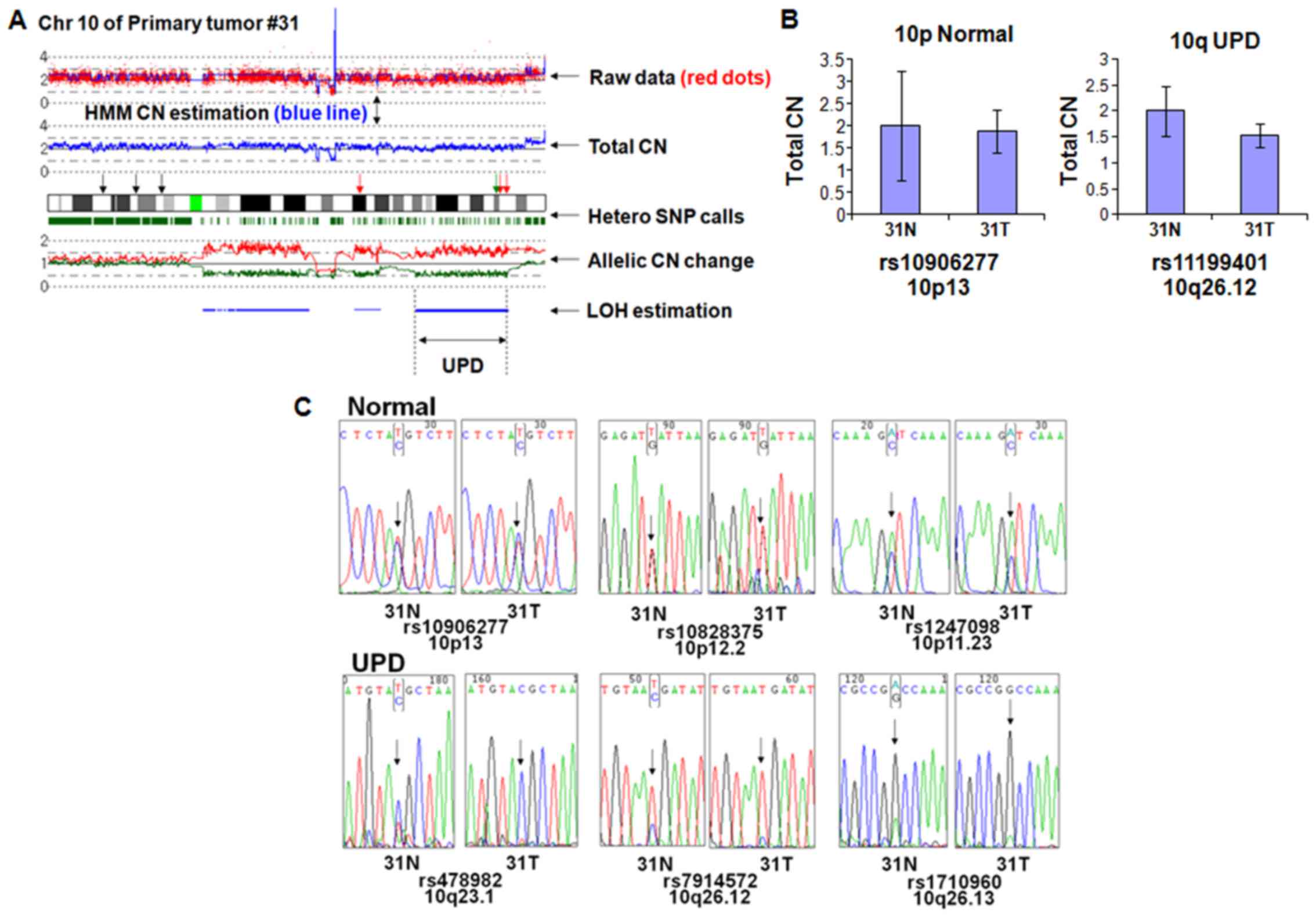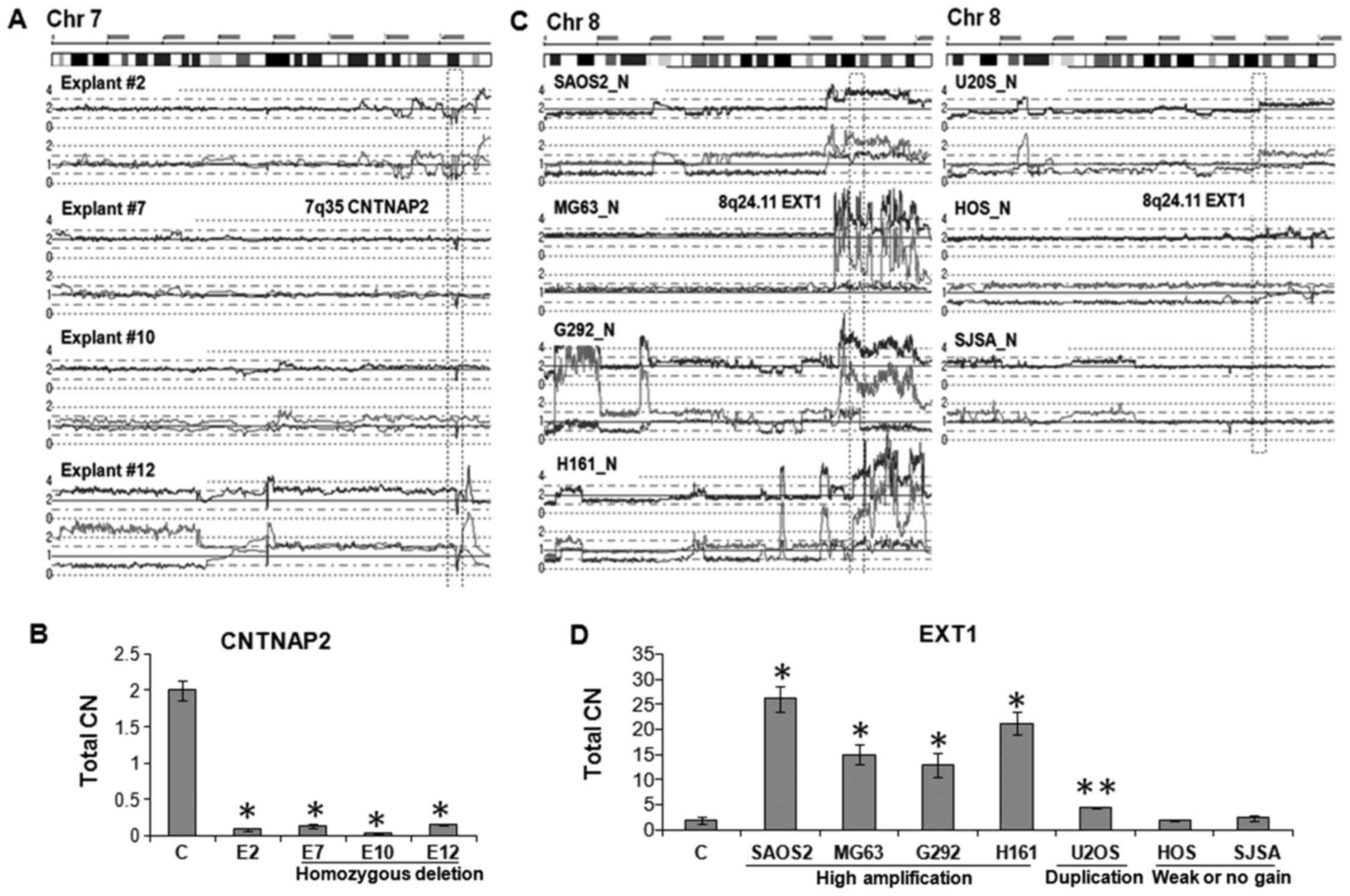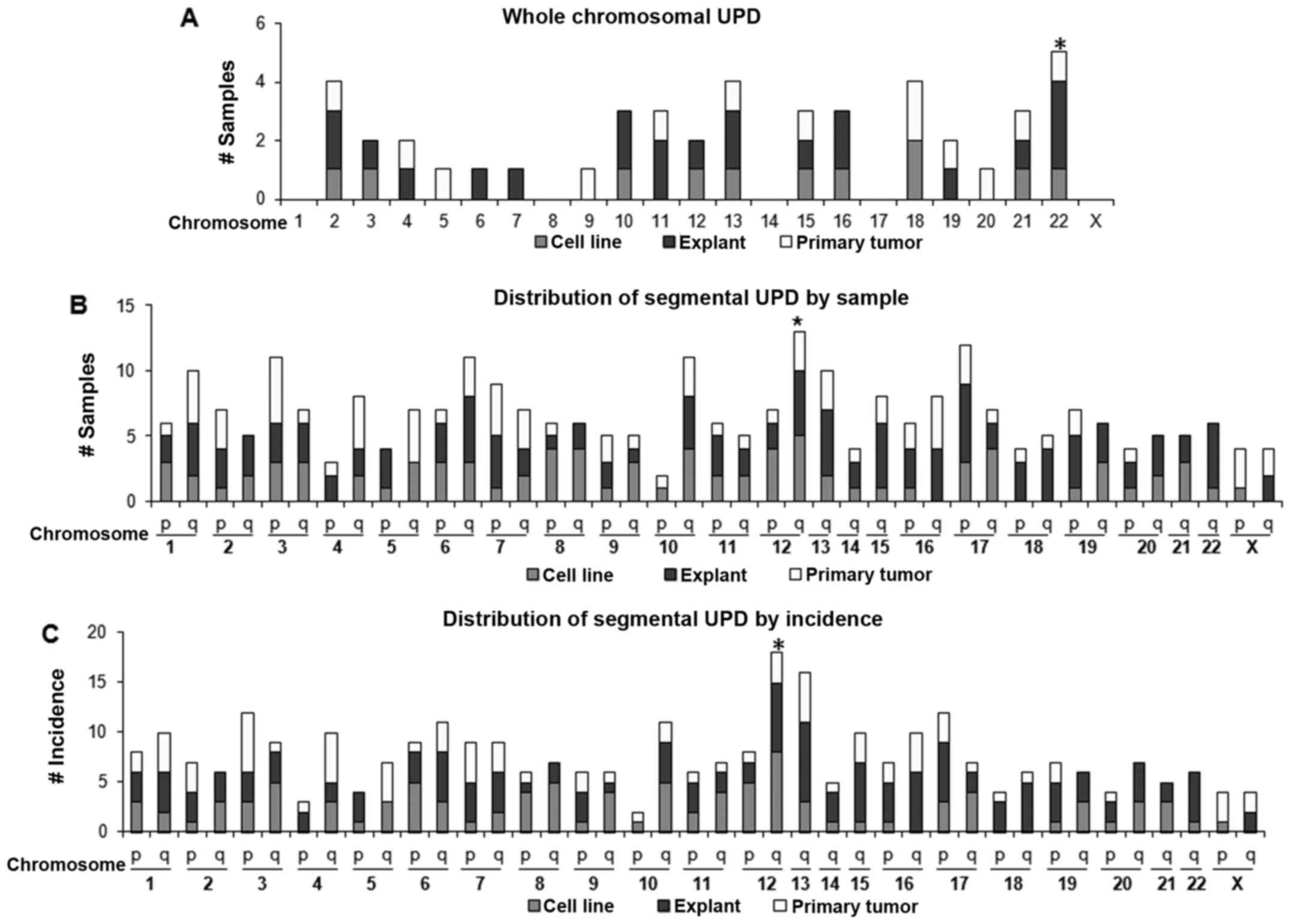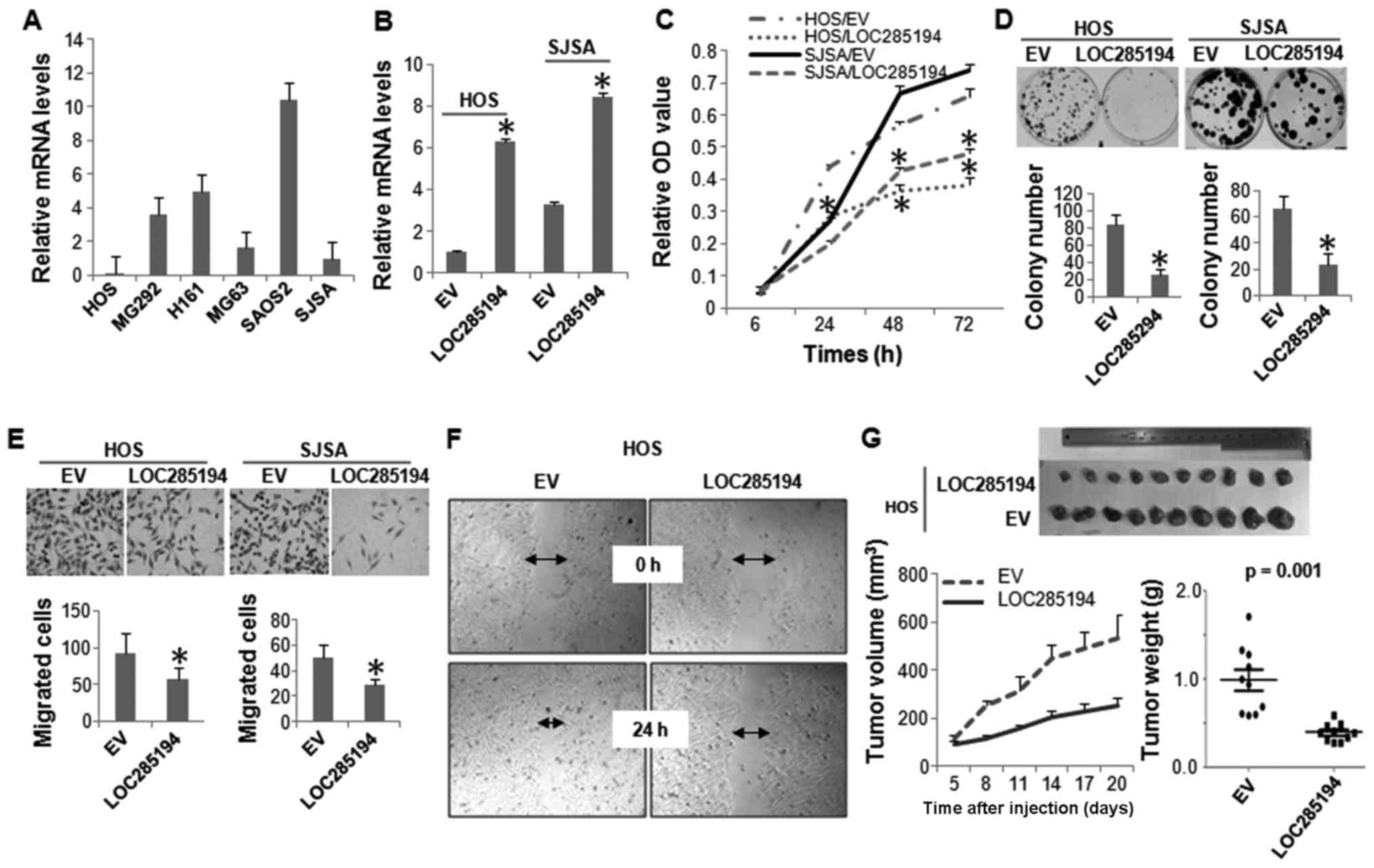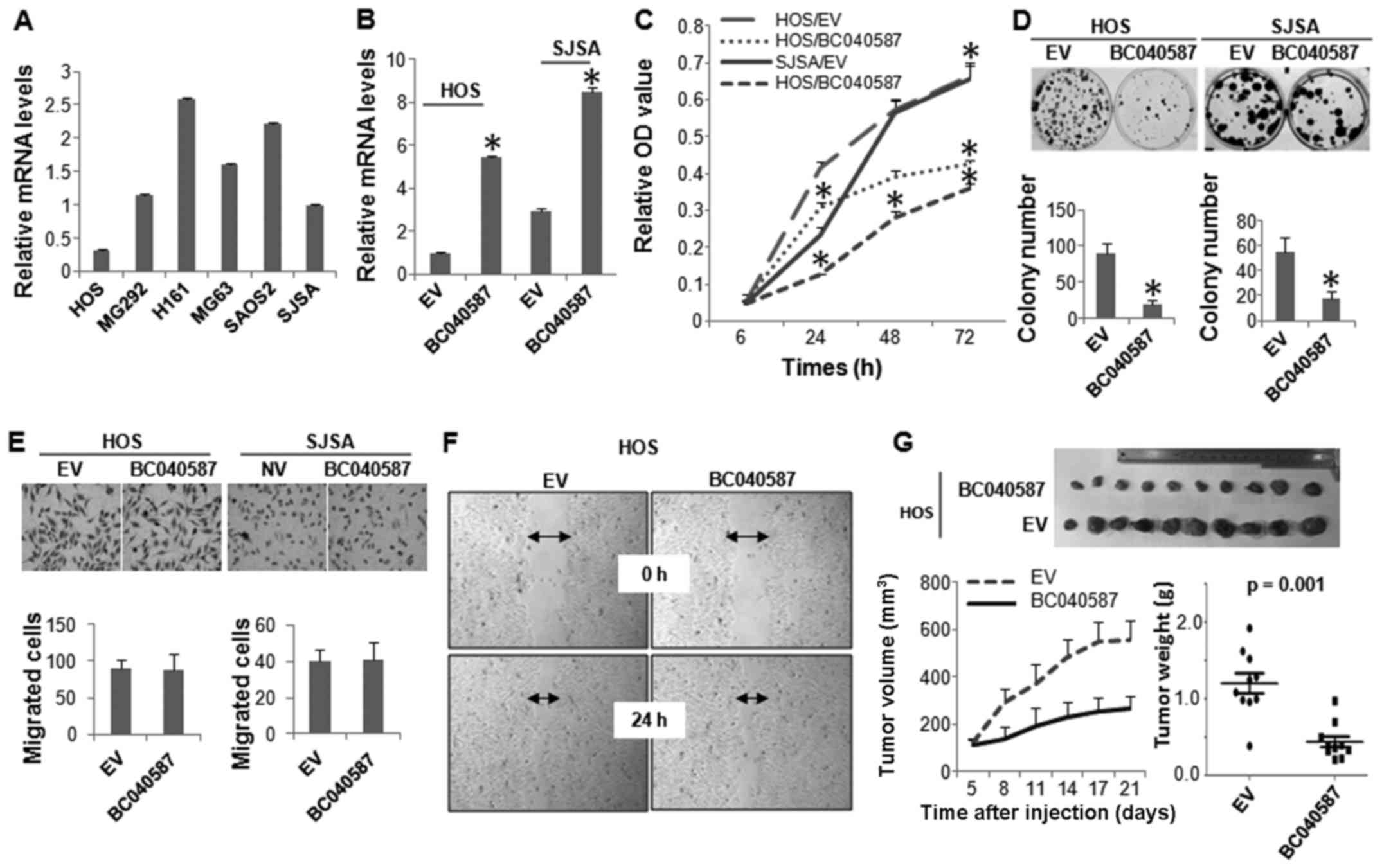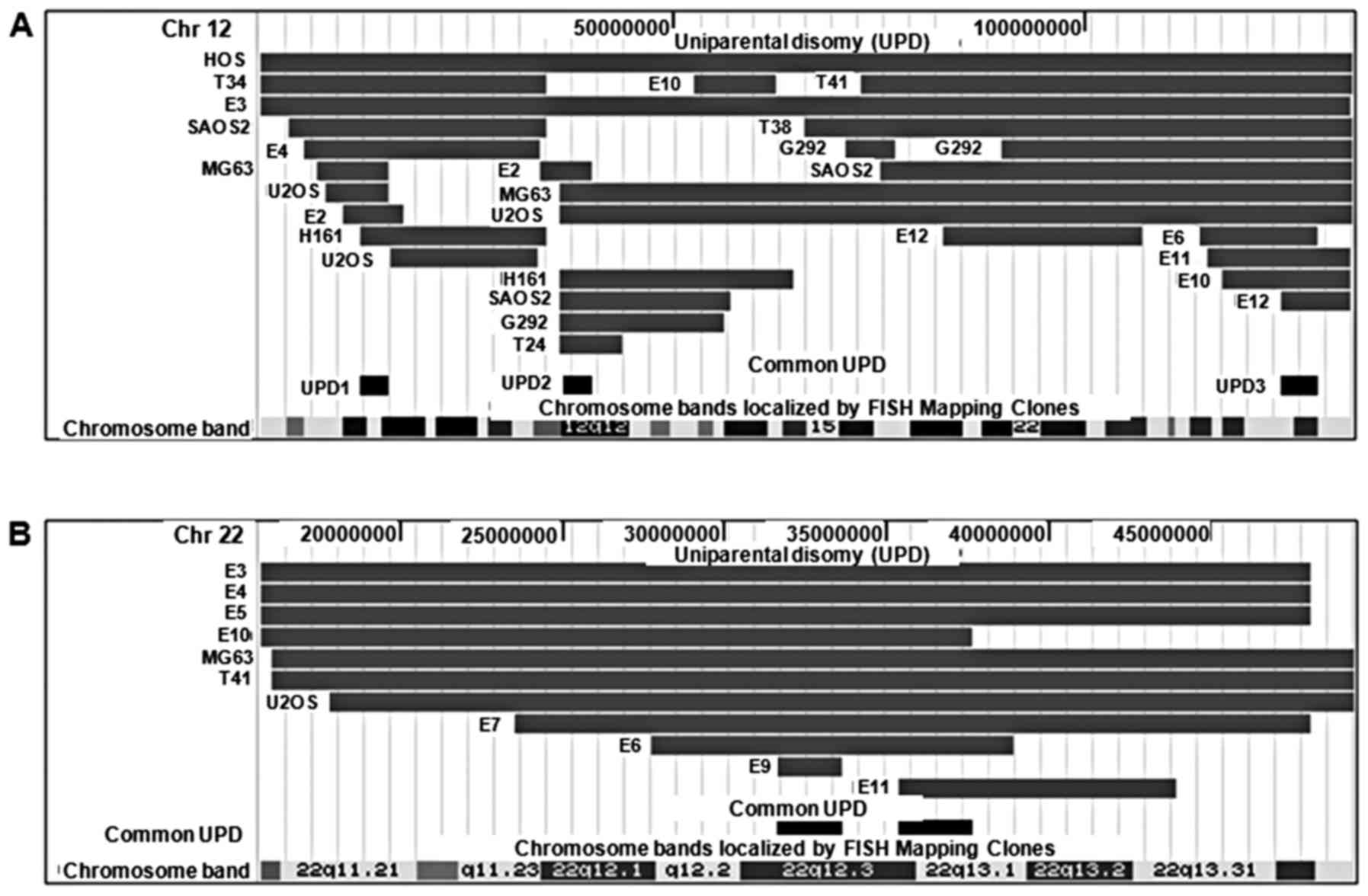Copy number analysis identifies tumor suppressive lncRNAs in human osteosarcoma
- Authors:
- Published online on: January 30, 2017 https://doi.org/10.3892/ijo.2017.3864
- Pages: 863-872
Abstract
Introduction
Although it is a rare bone tumor, the genetic alterations of osteosarcoma (OS) have been studied extensively (1–5). Nevertheless, the molecular cause of OS still remains elusive. This occurs in part because the tumor is relatively rare and it is composed of a heterogeneous population of tumor cells with complex chromosomal changes (1,2). OS is usually found in the metaphyseal region of the long bones especially during the growth spurt in the second decade of childhood (1,2). A second peak incidence of OS occurs in those who are 50 years and older (2). However, the molecular defects may be different in adults compared to children.
OS cells are generally undifferentiated (>80%) and osteoblastic (50–80%), suggesting that some of the initial genetic changes occur at the early stages of osteoblastogenesis (1,2). In addition, many cells show a high degree of chromosomal instability (CIN) including aneuploidy ranging from haploidy to near-hexaploidy, as well as ring chromosomes, and genomic amplification as seen by homozygously staining regions (hsr), and double minutes (dmin) (1).
For better description of CIN in OS, comparative genomic hybridization (CGH) has been widely used to date (1,6–13), which confirmed the recurrent amplifications and deletions found by conventional karyotyping such as amplification at 1q21-q22, 11p14-p15, 14p11-p13, 15p11-p13, and loss of chromosome 9, 10, 13 and 17. One limitation of the technique is that it is not able to detect allele-specific chromosomal events like copy-neutral loss of heterozygosity (CN-LOH) or uniparental disomy (UPD). Acquired UPD are important chromosomal changes known to be strongly related to cancer development (14). Allelic homozygosity by LOH can lead to the selection of either inactivating mutations of tumor suppressor genes (TSG) and/or dominant negative mutations of oncogenes (14). In this study, we analyzed OS by SNP array and successfully identified many hidden regions of UPD. Our study provides valuable information that can lead to the better understanding of the molecular mechanism of OS. Importantly, our analysis led to the identification of two novel tumor suppressive lncRNAs in this malignancy.
Materials and methods
Osteosarcoma samples and extraction of genomic DNA
Fifty-eight human OS samples were obtained from several sources: genomic DNA and total RNA from 40 primary OS tumors and from matched normal tissues were obtained from Dr Marc Hansen, and consent forms for molecular analyses were obtained. Genomic DNA from 11 OS explants were from Dr Carl Miller, and 7 OS cell lines (U2OS, G292, MG63, HT161, HOS, SAOS2, and SJSA). The human osteoblastic cell line hFOB1.19 was used as a normal control. All OS cell lines were maintained in DMEM medium (Mediatech Inc., Herndon, VA, USA) supplemented with 10% fetal bovine serum (Atlanta Biological, Lawrenceville, GA, USA). hFOB1.19 was maintained in DMEM/F12 medium without phenol red (Invitrogen, Carlsbad, CA, USA) supplemented with 10% FBS (Atlanta Biological) and cultured at 33°C. All the cell lines were authenticated in April 2016, by short tandem repeat analysis with the Geneprint 10 System kit (Promega, Madison, WI, USA). Genomic DNA was isolated with DNeasy genomic DNA purification kit (Qiagen, Valencia, CA, USA) according to the manufacturer's protocol. Quality of DNA was assessed by biophotometer (Eppendorf, Hambrug, Germany) and by gel electrophoresis prior to use.
SNP array analysis
Genomic DNA from 58 human OS samples were analyzed by GeneChip Human mapping single nucleotide polymorphism (SNP) arrays (Affymetrix, Santa Clara, CA, USA) as described before (15,16). 250K NspI SNP arrays were used for analysis, except for 11 explants which were analyzed by 50K XbaI SNP array. Briefly, 50 ng of genomic DNA purified from each sample was digested with either NspI for 250K array or with XbaI for 50K SNP array. Digested DNAs were ligated with adaptor and PCR amplified with LA Taq (Takara, Otsu, Shiga, Japan). Following amplification, DNA fragments were end-labeled with probes designed to differentiate SNP alleles and hybridized to SNP arrays. GeneChip Fluidics Station 400 and GeneChip scanner 3000 were used to produce raw data, which were then processed and analyzed by CN analyzer for Affymetrix GeneChip (CNAG 2.0) using allele-specific copy number analysis using anonymous reference (AsCNAR) algorithm (14). All allele-specific CN changes were automatically summarized by CNAG 2.0 using hidden-Markov model (HMM). Physical locations of chromosomal changes in the output file were based on UCSC genome browser. UPD from primary tumors with normal cell contamination were manually integrated. Copy number variants (CNV) were removed using genomic variants track in UCSC genome browser.
Validation of UPD and CN changes detected by SNP chip analysis in OS samples
Our SNP chip results were validated using genomic quantitative real-time PCR (q-PCR) and direct sequencing. Uniparental disomy (UPD) or copy-neutral loss of heterozygosity (CN-LOH) represents the loss of one allele and the duplication of the other. Therefore, a region of UPD should retain normal CN and have homozygosity at all SNP sites. As shown in Fig. 1A, chromosome 10 of primary tumor #31 has normal CN in p-arm (10p) and UPD in q-arm (10q). To minimize the effect of nucleotide composition on the genomic q-PCR results, we chose rs10906277 and rs11199401 retaining same nucleotide composition in both normal and tumor sample (data not shown). Genomic q-PCR revealed that the CN of 10p and 10q regions are almost the same between the tumor and matched normal, suggesting that UPD region at 10q has normal CN (Fig. 1B).
Next, we checked if the UPD region showed loss of heterozygosity by nucleotide sequencing. Three independent SNP sites within the normal CN region in 10p (rs10906277, rs10828375, and rs1247098) displayed heterozygosity (Fig. 1C, upper panels) in both the tumor and matched normal sample. In contrast, 3 independent SNP sites of the UPD region in 10q (rs478982, rs7914572 and rs1710960) showed homozygosity (Fig. 1C, lower panels) in the tumor sample but heterozygosity in the matched normal sample, suggesting that the UPD region had LOH in the tumor sample. Unequal ratio of the nucleotide signals in the UPD region probably results from normal cell contamination.
For other chromosomal changes, we further extended CN validation by genomic q-PCR. As shown in Fig. 2A, explant #2, #7, #10 and #12 had a shared homozygous deletion of the CNTNAP2 gene at 7q35. Genomic q-PCR analysis revealed that CN of the CNTNAP2 gene of each of these explants were significantly lower than normal genomic DNA sample (p<0.01) (Fig. 2B). In contrast, five OS cell lines including SAOS2, MG63, G292 and H161 had amplification (total CN>4) and U2OS had duplication of the EXT1 gene on 8q24.11 (Fig. 2C). Genomic q-PCR of these samples showed that CN of the EXT1 gene was 26-fold (SAOS2), 15-fold (MG63), 12-fold (G292), 21-fold (HT161), and 2-fold (U2OS) higher than normal genomic DNA sample (Fig. 2D; p<0.01 and p<0.05). These results validated that the chromosomal changes found by SNP chip are accurate and reliable.
Plasmids and transfection
The expression plasmid of LOC285194 (pCDH-LOC285194) was kindly provided by Dr Yin-Yuan Mo (University of Mississippi Medical Center) (17). Recombinant lentiviral vectors and packaging vectors were co-transfected into 293T cells using PEI transfection reagent and supernatants containing lentivirus were harvested 48 h after transfection as described before (18). HOS and SJSA cells were infected with the lentiviruses and supplemented with 8 mg/ml Polybrene (Sigma-Aldrich, St. Louis, MO, USA) and stable transfectants were selected with 1 µg/ml puromycin. For BC040586, the entire sequence was cloned and inserted into pCDNA3.1 vector. The expression plasmid or the empty vector was transfected into HOS and SJSA cells using BioT reagent (Bioland Scientific LLC, Paramount, CA, USA) and stable transfectants were selected with G418 (400 ng/ml).
Cell growth analysis in vitro
Cell growth was determined by MTT (3-(4, 5-dimethylthiazol-2-yl)-2, 5-diphenyl tetrazolium bromide) assay and cell colony formation assay. In MTT assay, cells were seeded onto 96-well plates (2,000 cells per well) and cell viability was assessed using MTT staining method at indicated time-points. Colony formation assay was performed by plating cells onto 6-well plates (500 cells per well). After 2 weeks, cells were fixed with methanol and stained with crystal violet. The number of colonies was counted and data are presented as mean ± SD from 3 independent experiments in triplicate wells.
Borden chamber cell migration assay
Cells (1×105) were seeded onto the top chamber of a 24-well membrane with 8-µm pores (Thermo Fisher Scientific, Waltham, MA, USA), and the bottom chamber was filled with medium containing 10% fetal calf serum. The membranes were fixed and stained with crystal violet 24 h after seeding, and migrated cells were quantified by microscopically counting 5 random fields at a magnification of ×200. Mean values were calculated from data obtained from three separate chambers.
Wound-healing assay
In wound-healing assays, cells were plated and grown to confluence for 24 h, then cells were starved in serum-free medium for 12 h, and a scratch was made across the monolayer using a sterile pipette tip. Wound closure result was imaged at 0 and 24 h with a microscope (×200).
Tumorigenesis experiment in nude mice
In vivo tumorigenesis assay was performed as described previously (19). In brief, ten 6-week-old female nude mice were subcutaneously injected with 2×106 HOS cells (overexpression of indicated lncRNA) on their dorsal flanks, with each mouse carrying four explants. Tumor growth was monitored and tumor size was measured every 3 days. Tumor volume was calculated using the formula, volume = 1/2 (length × width2). After 20 days, the mice were sacrificed and the tumors were removed and weighed. All animal studies were conducted in accordance with NIH animal use guidelines and were approved by the Institutional Animal Care and Use Committee (IACUC) at Cedars-Sinai Medical Center.
Statistical analysis
Two-tailed Student's t-test was used to analyze the potential statistical difference between two groups. Statistical significance was set at p<0.05.
Results
Recurrent UPD regions in OS
Among thousands of recognizable chromosomal changes in 59 OS samples, we found 950 LOH regions including 355 sites of UPD (data available upon request). All samples had LOH. To our surprise, 37% of LOH were in the form of UPD, highlighting its prevalence in OS. Interestingly, a total of 98 LOH events spanned the whole chromosome, among which, 53 LOH were monosomy and 45 LOH were whole-chromosomal UPD. Monosomy occurred most frequently at chromosomes 13 and 16 (7 cases each), no monosomy was identified at chromosomes 4, 5 and 7. Whole-chromosomal UPD (Fig. 3A) was most frequent at chromosome 22 (5 cases) followed by chromosomes 2, 13 and 18 (4 cases each). No whole-chromosomal UPD was noted at either chromosome 1, 8, 14 or 17. Interestingly, chromosomes 1, 8, 14 and 17 had regions of recurrent high amplification (discussed later).
Concerning segmental UPD (Figs. 1C and 3B), chromosome 12 q-arm (12q) UPD occurred the most frequently in 13 samples (22%). The next most common was 17q UPD found in 12 samples (20%); by incidence, 12q UPD was also the most frequent (18 regions) followed by 13q UPD (16 regions).
Seventy percent of the primary samples had one or more recurrent UPD regions, and 100% of cell lines and explants had recurrent UPD regions. Regions of recurrent UPD appeared in various sizes and chromosomal loci (Table I). Excluding whole-chromosomal UPD, the median size of the UPD regions was 11 Mb, ranging from 2 Mb (Xp22.12 and Xp22.12-p21.3) to 54 Mb (whole q-arm UPD of chromosome 16).
Moreover, recurrent UPD regions contained genes known to be frequently mutated in OS (Table I). For example, RB1 and TP53, two of the most commonly mutated genes in OS (1,2), occurred in the recurrent UPD regions of chromosomes 13 and 17, respectively. CDKN2A and CDKN2B, two well-known TSG, were not only in a recurrent UPD region, but also showed recurrent homozygous deletions (HD) in many samples (Table II). EGFR gene was also found in the recurrent UPD region of chromosome 7. We have extensively validated UPD and CN changes (shown below) through both genomic q-PCR and direct sequencing (Materials and methods and Figs. 1 and 2).
Recurrent amplifications and homozygous deletions in OS
We analyzed total CN changes and identified common regions of amplification showing CN estimation of 5 and 6 determined by HMM. Eleven regions were commonly amplified region in OS cells (Table III). Common amplifications at 1q21.1-1q24.1, 6p21.1-p12.1, 8q23.3-q24.3, 14q11.2-q12 and 17p12-p11 have been reported (1–13), showing that these region are frequently amplified in OS cells. Next, we identified homozygous deletions (HD) and found 196 recurrent HD in total (Table II). Many HD occurred in the vicinity of genes located at common fragile sites (CFS) e.g., LRP1B (FRA2F), CNTNAP2 (FRA7I), MAGI2 (FRA7E), DLG2 (FRA11F) and DMD (FRAXC). These genes are deleted in many cancers.
Importantly, homozygous deletion of 3q13.31 was the most frequent HD (10 cases; 17% of the samples) in our cohort. This region contained either a 5′-portion of LSAMP gene, lncRNAs LOC285194 or BC040587, or all three, in agreement with a recent report (20). In many cases, deletion of LOC285194 and BC040587 (7 cases) was more frequent than deletion of LSAMP gene (3 cases), suggesting that these two lncRNAs might be biologically relevant in OS cells.
Both LOC285194 and BC040587 play important roles in the proliferation and migration of OS cells
Although LOC285194 has been implicated as a tumor suppressor lncRNA in OS (20), its function has not been studied extensively. Moreover, the biological relevance of BC040587 remains unknown in the context of OS. To address this, we next sought to characterize the functional roles of both LOC285194 and BC040587 in OS cells.
Expression level of LOC285194 was determined in a panel of OS cell lines by qRT-PCR analysis. It was expressed at low levels in all the OS cells lines evaluated. Not surprisingly, LOC285194 was almost undetectable in HOS cells, which has HD at this genomic locus (Fig. 4A). We next ectopically expressed LOC285194 in both HOS and SJSA cells, both displayed the lowest expression of this lncRNA (Fig. 4B). Both MTT and colony formation assays showed that restoration of LOC285194 markedly attenuated the proliferation of both HOS and SJSA cells (Fig. 4C and D). Moreover, Boyden chamber migration assay and wound-healing assay revealed that LOC285194 expression resulted in a significantly decreased cell migration (Fig. 4E and F). To determine whether LOC285194 regulates xenograft growth of OS cells in vivo, we injected either LOC285194-restored or control HOS cells into the nude mice. Consistent with the effects of LOC285194 expression in vitro, LOC285194 potently inhibited xenograft growth (Fig. 4G).
We next performed biological assays to determine the functional role of the other lncRNA, BC040587, in OS cells. Similar to LOC285194, HOS cells expressed the lowest level of BC040587, followed by SJSA cells (Fig. 5A). BC040587 was ectopically expressed in these two cell lines (Fig. 5B), which markedly inhibited their cellular proliferation (Fig. 5C and D). However, unlike LOC285194, expression of BC040587 did not affect the migration of the OS cells (Fig. 5E and F). The tumor suppressive function of BC040587 was further confirmed by in vivo xenograft assay (Fig. 5G).
Discussion
Unlike CGH studies which focused on primary tumors, our study used OS from three different sources: 7 cell lines, 11 explants and 40 primary tumors. The cell lines and explants maintained the chromosomal aberrations found in primary tumors. The same phenomenon was observed in malignant melanoma where the overall genomic profiles of 101 melanoma cell lines nearly matched those of 70 primary melanomas (21). Similar concordness was noted between 26 pancreatic cancer cell lines and primary pancreatic cancers (22). Thus, combining the results of all 59 samples into one analysis of common chromosomal changes in OS is reasonable.
Our analysis particularly focused on the study of LOH, especially UPD. Notably, almost 37% of the LOH were hidden as UPD. Although surprising, esophageal cancer (23) and basal cell carcinoma (24) also had UPD, with 33% of the total number of chromosomal changes and 42% of the total LOH, respectively.
Among all UPD regions, 12q UPD occurred with the highest frequency (18 events) affecting the highest number of samples (13 samples, 23%). Two recurrent UPD regions were identified on 12q: 12q11-q12 (UPD2) and 12q24.31-q24.32 (UPD3) (Fig. 6A). Interestingly, the location of the recurrent UPD regions, either centromeric (UPD2) or telomeric (UPD3), suggests that these UPD regions were a result of somatic recombination.
Although its incidence was relatively lower than chromosome 12, chromosome 22 UPD was interesting in that nearly half of the UPD (45%) (Fig. 6B), involved the whole-chromosome suggesting that the mechanism of UPD formation might be different from those of other UPD regions. Among the genes in the region, CSNK1E gene is a potential target because of its important role in canonical Wnt signaling pathway and in circadian rhythm signaling pathway. Interestingly, many genes in the recurrent UPD regions play major roles in the Wnt signaling pathway, especially in the canonical Wnt signaling pathway (data not shown). Previous research shows that canonical Wnt signaling pathway is deregulated in OS (25,26). For example, Ng et al (27) checked the cellular location of β-catenin in 545 mesenchymal tumors including 19 OS and found that OS showed an accumulation of β-catenin in nucleus and/or in cytoplasm.
Frequent HD involving 3q13.31 region has been observed in OS (20,28,29). Among the genes located within the deleted region, LSAMP, together with two lncRNAs LOC285194 and BC040587, were highlighted. Variable levels of these two lncRNAs in different osteosarcoma cell lines were observed. It is not surprising that LOC285194 and BC040587 were expressed at their lowest level in HOS cells, as this line has a homozygous deletion at this genomic locus. Among the other cell lines, no appreciable copy number changes were detected, and we reasoned that the different RNA levels might result from epigenetic alterations, such as DNA methylation or histone modification. Previous reports noted that silencing LOC285194 promoted proliferation of normal osteoblasts, and HD of LOC285194 or BC040587 was associated with a poor survival of OS patients (17,20). We show that restoration of either LOC285194 or BC040587 in OS cell lines potently suppressed cell proliferation in vitro and in vivo, consistent with the tumor suppressive roles of these two lncRNAs. We also found that expression of LOC285194 but not BC040587 inhibited the migration of OS cells. Continuing research will be needed to elucidate the mode of action of these two lncRNAs.
In conclusion, we discovered that OS has frequent deletions and many of these represent chromosome region with mutation of one allele of a target gene and its duplication with less of the second normal allele. These target genes are usually tumor suppressor genes. Hence, OS probably has numerous mutant tumor suppressor genes.
Acknowledgments
This study was supported by the Singapore Ministry of Health's National Medical Research Council (NMRC) under its Singapore Translational Research (STaR) Investigator Award to H.P.K., NMRC Individual Research Grant (NMRC/1311/2011) and the NMRC Centre Grant awarded to National University Cancer Institute of Singapore, the National Research Foundation Singapore and the Singapore Ministry of Education under its Research Centres of Excellence initiatives to H.P.K. D.-C.L. was supported by American Society of Hematology Fellow Scholar Award, Donna and Jesse Garber Awards for Cancer Research and National Center for Advancing Translational Sciences UCLA CTSI Grant UL1TR000124. This study was also supported by the Wendy Walk Foundation, Slifka Foundation and the RNA Biology Center at the Cancer Science Institute of Singapore, NUS, as part of funding under the Singapore Ministry of Education's Tier 3 grants (grant no. MOE2014-T3-1-006).
References
|
Sandberg AA and Bridge JA: Updates on the cytogenetics and molecular genetics of bone and soft tissue tumors: Osteosarcoma and related tumors. Cancer Genet Cytogenet. 145:1–30. 2003. View Article : Google Scholar : PubMed/NCBI | |
|
Kansara M and Thomas DM: Molecular pathogenesis of osteosarcoma. DNA Cell Biol. 26:1–18. 2007. View Article : Google Scholar : PubMed/NCBI | |
|
Savage SA, Mirabello L, Wang Z, Gastier-Foster JM, Gorlick R, Khanna C, Flanagan AM, Tirabosco R, Andrulis IL, Wunder JS, et al: Genome-wide association study identifies two susceptibility loci for osteosarcoma. Nat Genet. 45:799–803. 2013. View Article : Google Scholar : PubMed/NCBI | |
|
Mirabello L, Koster R, Moriarity BS, Spector LG, Meltzer PS, Gary J, Machiela MJ, Pankratz N, Panagiotou OA, Largaespada D, et al: A genome-wide scan identifies variants in NFIB associated with metastasis in patients with osteosarcoma. Cancer Discov. 5:920–931. 2015. View Article : Google Scholar : PubMed/NCBI | |
|
Kovac M, Blattmann C, Ribi S, Smida J, Mueller NS, Engert F, Castro-Giner F, Weischenfeldt J, Kovacova M, Krieg A, et al: Exome sequencing of osteosarcoma reveals mutation signatures reminiscent of BRCA deficiency. Nat Commun. 6:89402015. View Article : Google Scholar : PubMed/NCBI | |
|
dos Santos Aguiar S, de Jesus Girotto Zambaldi L, dos Santos AM, Pinto W Jr and Brandalise SR: Comparative genomic hybridization analysis of abnormalities in chromosome 21 in childhood osteosarcoma. Cancer Genet Cytogenet. 175:35–40. 2007. View Article : Google Scholar : PubMed/NCBI | |
|
Ohata N, Ito S, Yoshida A, Kunisada T, Numoto K, Jitsumori Y, Kanzaki H, Ozaki T, Shimizu K and Ouchida M: Highly frequent allelic loss of chromosome 6q16-23 in osteosarcoma: Involvement of cyclin C in osteosarcoma. Int J Mol Med. 18:1153–1158. 2006.PubMed/NCBI | |
|
Atiye J, Wolf M, Kaur S, Monni O, Böhling T, Kivioja A, Tas E, Serra M, Tarkkanen M and Knuutila S: Gene amplifications in osteosarcoma-CGH microarray analysis. Genes Chromosomes Cancer. 42:158–163. 2005. View Article : Google Scholar | |
|
Zielenska M, Marrano P, Thorner P, Pei J, Beheshti B, Ho M, Bayani J, Liu Y, Sun BC, Squire JA, et al: High-resolution cDNA microarray CGH mapping of genomic imbalances in osteosarcoma using formalin-fixed paraffin-embedded tissue. Cytogenet Genome Res. 107:77–82. 2004. View Article : Google Scholar : PubMed/NCBI | |
|
Man TK, Lu XY, Jaeweon K, Perlaky L, Harris CP, Shah S, Ladanyi M, Gorlick R, Lau CC and Rao PH: Genome-wide array comparative genomic hybridization analysis reveals distinct amplifications in osteosarcoma. BMC Cancer. 4:452004. View Article : Google Scholar : PubMed/NCBI | |
|
Lau CC, Harris CP, Lu XY, Perlaky L, Gogineni S, Chintagumpala M, Hicks J, Johnson ME, Davino NA, Huvos AG, et al: Frequent amplification and rearrangement of chromosomal bands 6p12-p21 and 17p11.2 in osteosarcoma. Genes Chromosomes Cancer. 39:11–21. 2004. View Article : Google Scholar | |
|
Squire JA, Pei J, Marrano P, Beheshti B, Bayani J, Lim G, Moldovan L and Zielenska M: High-resolution mapping of amplifications and deletions in pediatric osteosarcoma by use of CGH analysis of cDNA microarrays. Genes Chromosomes Cancer. 38:215–225. 2003. View Article : Google Scholar : PubMed/NCBI | |
|
Overholtzer M, Rao PH, Favis R, Lu XY, Elowitz MB, Barany F, Ladanyi M, Gorlick R and Levine AJ: The presence of p53 mutations in human osteosarcomas correlates with high levels of genomic instability. Proc Natl Acad Sci USA. 100:11547–11552. 2003. View Article : Google Scholar : PubMed/NCBI | |
|
Yamamoto G, Nannya Y, Kato M, Sanada M, Levine RL, Kawamata N, Hangaishi A, Kurokawa M, Chiba S, Gilliland DG, et al: Highly sensitive method for genomewide detection of allelic composition in nonpaired, primary tumor specimens by use of affymetrix single-nucleotide-polymorphism genotyping microarrays. Am J Hum Genet. 81:114–126. 2007. View Article : Google Scholar : PubMed/NCBI | |
|
Lin DC, Meng X, Hazawa M, Nagata Y, Varela AM, Xu L, Sato Y, Liu LZ, Ding LW, Sharma A, et al: The genomic landscape of nasopharyngeal carcinoma. Nat Genet. 46:866–871. 2014. View Article : Google Scholar : PubMed/NCBI | |
|
Lin DC, Xu L, Ding LW, Sharma A, Liu LZ, Yang H, Tan P, Vadgama J, Karlan BY, Lester J, et al: Genomic and functional characterizations of phosphodiesterase subtype 4D in human cancers. Proc Natl Acad Sci USA. 110:6109–6114. 2013. View Article : Google Scholar : PubMed/NCBI | |
|
Liu Q, Huang J, Zhou N, Zhang Z, Zhang A, Lu Z, Wu F and Mo YY: lncRNA loc285194 is a p53-regulated tumor suppressor. Nucleic Acids Res. 41:4976–4987. 2013. View Article : Google Scholar : PubMed/NCBI | |
|
Lin DC, Xu L, Chen Y, Yan H, Hazawa M, Doan N, Said JW, Ding LW, Liu LZ, Yang H, et al: Genomic and functional analysis of the E3 ligase PARK2 in glioma. Cancer Res. 75:1815–1827. 2015. View Article : Google Scholar : PubMed/NCBI | |
|
Jiang YY, Lin DC, Mayakonda A, Hazawa M, Ding LW, Chien WW, Xu L, Chen Y, Xiao JF, Senapedis W, et al: Targeting super-enhancer-associated oncogenes in oesophageal squamous cell carcinoma. Gut. May 10–2016.Epub ahead of print. 2016.PubMed/NCBI | |
|
Pasic I, Shlien A, Durbin AD, Stavropoulos DJ, Baskin B, Ray PN, Novokmet A and Malkin D: Recurrent focal copy-number changes and loss of heterozygosity implicate two noncoding RNAs and one tumor suppressor gene at chromosome 3q13.31 in osteosarcoma. Cancer Res. 70:160–171. 2010. View Article : Google Scholar : PubMed/NCBI | |
|
Lin WM, Baker AC, Beroukhim R, Winckler W, Feng W, Marmion JM, Laine E, Greulich H, Tseng H, Gates C, et al: Modeling genomic diversity and tumor dependency in malignant melanoma. Cancer Res. 68:664–673. 2008. View Article : Google Scholar : PubMed/NCBI | |
|
Calhoun ES, Hucl T, Gallmeier E, West KM, Arking DE, Maitra A, Iacobuzio-Donahue CA, Chakravarti A, Hruban RH and Kern SE: Identifying allelic loss and homozygous deletions in pancreatic cancer without matched normals using high-density single-nucleotide polymorphism arrays. Cancer Res. 66:7920–7928. 2006. View Article : Google Scholar : PubMed/NCBI | |
|
Nancarrow DJ, Handoko HY, Smithers BM, Gotley DC, Drew PA, Watson DI, Clouston AD, Hayward NK and Whiteman DC: Genome-wide copy number analysis in esophageal adenocarcinoma using high-density single-nucleotide polymorphism arrays. Cancer Res. 68:4163–4172. 2008. View Article : Google Scholar : PubMed/NCBI | |
|
Teh MT, Blaydon D, Chaplin T, Foot NJ, Skoulakis S, Raghavan M, Harwood CA, Proby CM, Philpott MP, Young BD, et al: Genomewide single nucleotide polymorphism microarray mapping in basal cell carcinomas unveils uniparental disomy as a key somatic event. Cancer Res. 65:8597–8603. 2005. View Article : Google Scholar : PubMed/NCBI | |
|
Xue YL, Meng XQ, Ma LJ and Yuan Z: Plumbagin exhibits an anti-proliferative effect in human osteosarcoma cells by downregulating FHL2 and interfering with Wnt/β-catenin signalling. Oncol Lett. 12:1095–1100. 2016.PubMed/NCBI | |
|
Lv YF, Dai H, Yan GN, Meng G, Zhang X and Guo QN: Downregulation of tumor suppressing STF cDNA 3 promotes epithelial-mesenchymal transition and tumor metastasis of osteosarcoma by the Wnt/GSK-3β/β-catenin/Snail signaling pathway. Cancer Lett. 373:164–173. 2016. View Article : Google Scholar : PubMed/NCBI | |
|
Ng TL, Gown AM, Barry TS, Cheang MC, Chan AK, Turbin DA, Hsu FD, West RB and Nielsen TO: Nuclear beta-catenin in mesenchymal tumors. Mod Pathol. 18:68–74. 2005. View Article : Google Scholar | |
|
Yen CC, Chen WM, Chen TH, Chen WY, Chen PC, Chiou HJ, Hung GY, Wu HT, Wei CJ, Shiau CY, et al: Identification of chromosomal aberrations associated with disease progression and a novel 3q13.31 deletion involving LSAMP gene in osteosarcoma. Int J Oncol. 35:775–788. 2009.PubMed/NCBI | |
|
Kresse SH, Ohnstad HO, Paulsen EB, Bjerkehagen B, Szuhai K, Serra M, Schaefer KL, Myklebost O and Meza-Zepeda LA: LSAMP, a novel candidate tumor suppressor gene in human osteosarcomas, identified by array comparative genomic hybridization. Genes Chromosomes Cancer. 48:679–693. 2009. View Article : Google Scholar : PubMed/NCBI |



